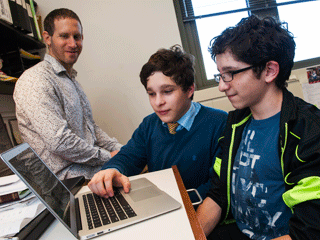A new web tool effectively prioritizes disease-causing genes by biological distance

(Medical Xpress)—A new tool, essentially a genetic navigation system that can help biologists identify connections and measure distances between human genes, has received an upgrade. Now, just as with Google Maps, anyone can access the Human Gene Connectome, without training in computational biology or the need to learn special syntax.
Using the new, online Human Gene Connectome, a physician, immunologist or any other investigator can plug the names of potential disease-causing genes into search fields and rank them based on a new metric called biological distance.
It wasn't always so easy. The original version of the Human Gene Connectome required someone to not only download a massive amount of data, but also to open up a terminal window and type in lines of code. This requirement prompted the onset of "terminal command line phobia" in some, says Yuval Itan, the principal researcher behind the project and a postdoc in the St. Giles Laboratory of Human Genetics of Infectious Disease led by Jean-Laurent Casanova.
"It wasn't enough for the system to work, we needed to make it widely accessible, and we have accomplished that, in part, thanks to the efforts of two high school students," Itan says.
The students, Benjamin and Mark Mazel, were placed in the lab through the university's Summer Science Research Program and spent their summer giving the system its more user-friendly interface. They are co-authors of a paper published in BMC Genomics last week announcing the site's debut.
The biological distance metric generated by the system can implicate a single gene in a disease, which is the goal of the Casanova laboratory. Typically, this process begins with a list of hundreds or thousands of candidate genes that carry mutations in a patient. The investigator first looks for mutations in genes known to cause disease, and if none are present, which is often the case, the next question is: Which genes on this list belong to the same pathway or have a similar function as known disease causing genes?
The search often ends here, since literature searches become overwhelming and other conventional tools are limited. Itan and colleagues offered a new solution when they first described the Human Gene Connectome last year in the Proceedings of the National Academy of Sciences.
"We can now take any two human genes and then navigate and measure the distance between the two of them by one click of a button, basically in the same way you would use GPS to navigate with a car," Itan says. "In this case, the input for navigation involves physical binding interactions between the proteins encoded by the genes rather than traveling from street to street."
More information: "HBCS: an online tool for prioritizing disease-causing gene variants by biological distance." Yuval Itan, Mark Mazel, Benjamin Mazel, Avinash Abhyankar, Patrick Nitschke, Lluis Quintana-Murci, Stephanie Boisson-Dupuis, Bertrand Boisson, Laurent Abel, Shen-Ying Zhang and Jean-Laurent Casanova. BMC Genomics 15: 256 (April 3, 2014)DOI: 10.1186/1471-2164-15-256

















